Regulate, relate, then reason. Trying to reason with someone before they are regulated won’t work and indeed will only increase frustration (dysregulation) for both of you. Effective communication, teaching, coaching, parenting, and therapeutic input require awareness of, and adherence to, the sequence of engagement. (See image below)
Our brain is continually getting input from our body (interoception) and the world (five senses). These incoming signals are processed in a sequential fashion, with the first sorting taking place in the lower brain (brainstem, diencephalon). To reason with another person, we need to effectively get through the lower areas of their brain and reach their cortex, the part responsible for thinking, including problem-solving and reflective cognition. But if someone is stressed, angry, frustrated, or otherwise dysregulated, the incoming input will be short-circuited, leading to inefficient, distorted input to the cortex. This is where the sequence of engagement comes in. Without some degree of regulation, it is difficult to connect with another person, and without connection, there is minimal reasoning.
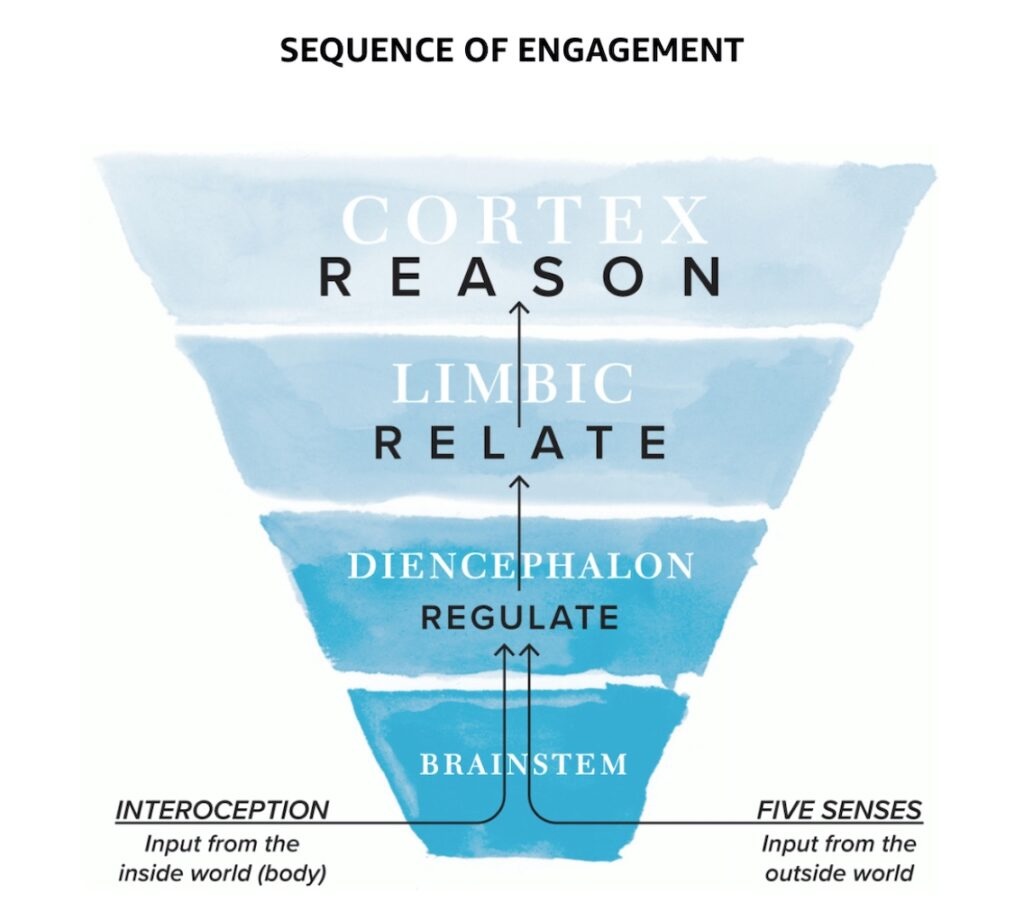
From What Happened to You? by Dr. Bruce D. Perry & Oprah Winfrey
Dr. Bruce Perry’s “Regulate, Relate, Reason” framework can be incredibly beneficial for couples as it allows us to be in line with neuroscience and use our nervous system and attachment needs to get back to a regulated state.
In the context of Relational Practice, Louise Bloomer has added a fourth R: Repair or Restore. Why? When we are distressed or dysregulated, we can say or do things that cause harm. When this happens it’s necessary to try to repair or restore the situation or relationship to return to normality and get on with learning and navigating life.
Here’s how these R’s apply in our relationship.
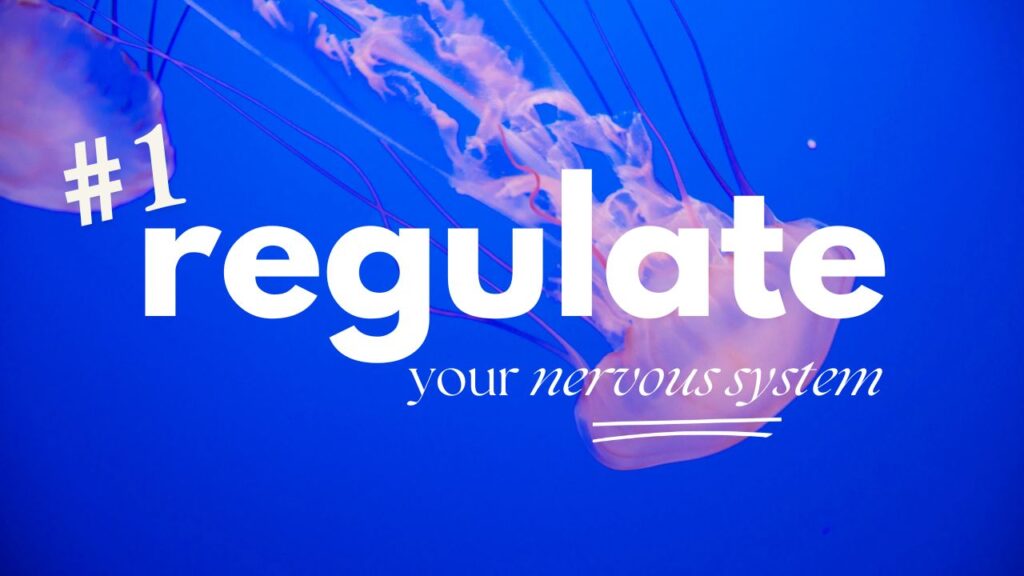
Individual Level:
Each partner needs to manage their own emotions and reactions. This involves recognizing when you’re becoming triggered or overwhelmed, using self-soothing techniques, and taking breaks when needed. This also means allowing your partner to take the time to process and recover while you lean onto techniques like mindfulness, deep breathing, music, movement, and progressive muscle relaxation to regulate your emotions.
Remember: The most important thing you can do for your partner during conflict or when they’re in emotional distress is to self-regulate. This means finding a place of calm within yourself. You might get there by using this simple exercise: Inhale for 4 seconds. Exhale for 8 seconds.
Couple Level:
Create a safe space where both partners feel heard and respected. Avoid escalating arguments by using a calm tone of voice and non-threatening body language. Statements that can be helpful to de-escalate or regulate with your partner:
- “I’m right here. Let’s slow this down and try to hear each other.”
- “This is a hard topic and we both have good reasons to have big feelings.”
- “Let’s take some breaths together… we’re letting our fear get in the way of our love or understanding.”
- “Let’s pause and take turns telling each other what we need to feel safe right now.”
- “I love our relationship more than I love this argument.”
- “Can I take that back? Let me try again.”
- “I want to say this more gently but I don’t know how to right now.”
- “I need your support right now.”
- “Wait, let me just reset myself. I’m starting to go to a place where I’m not open and you deserve my openness. Give me an X amount of time to settle myself.”
- “Can we take a break and come back in X amount of time? I need to feel calmer/gather my thoughts.”
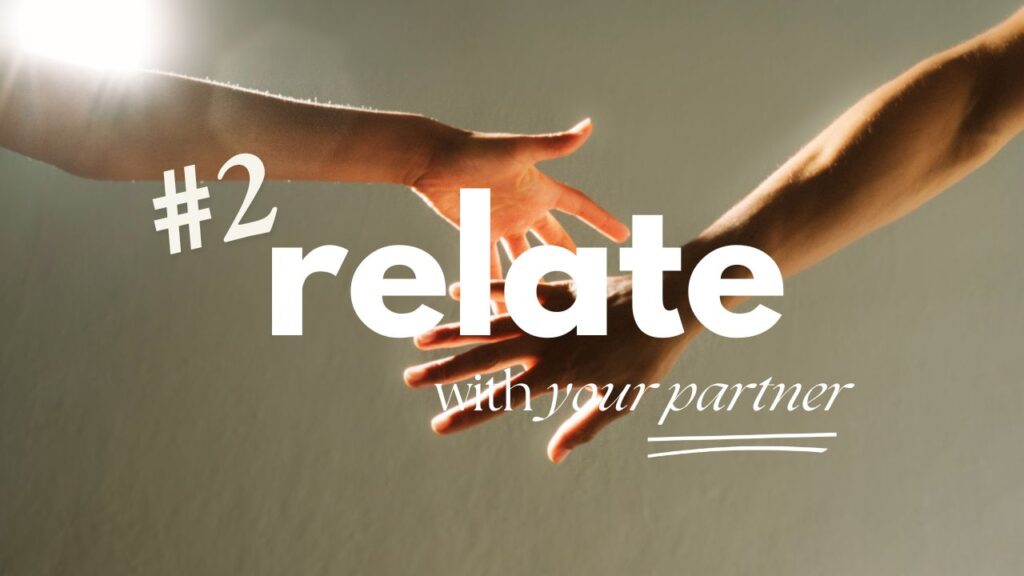
Empathy and Understanding:
Use your relationship to help your partner feel safe and connected – be attuned to them emotionally. Use the power of ‘noticing,’ i.e., notice and name the emotion, for example, I can see you are…frustrated, upset, angry, worried, sad, etc.
Validate their feelings and experiences, even if you don’t agree with them or their behavior. Use words like:
- “I see you”
- “I hear you”
- “I understand”
- “It makes sense that…”
- “I’m on your team”
- “I know this is hard…”
- “I can see you’re angry, but when you talk to me in that tone or with that volume, it makes it hard for me to listen to you. Can you try saying that softly, calmly, and non-defensively?”
Focus on Emotional Connection First:
There’s a time and a place for problem-solving, and there’s a time and place for just being a supportive, comforting presence. When your partner is in distress, focus on support first. Why?
Connection helps us to calm our nervous system. When we are around people we care about & trust, our bodies produce oxytocin, the hormone responsible for calming our nervous system after stress. You can then go into problem-solving and reasoning after establishing a sense of safety which is key to feeling open and curious.
When not in conflict, build a strong bond by expressing love and appreciation for each other. Spend quality time together and engage in activities that foster intimacy and connection.
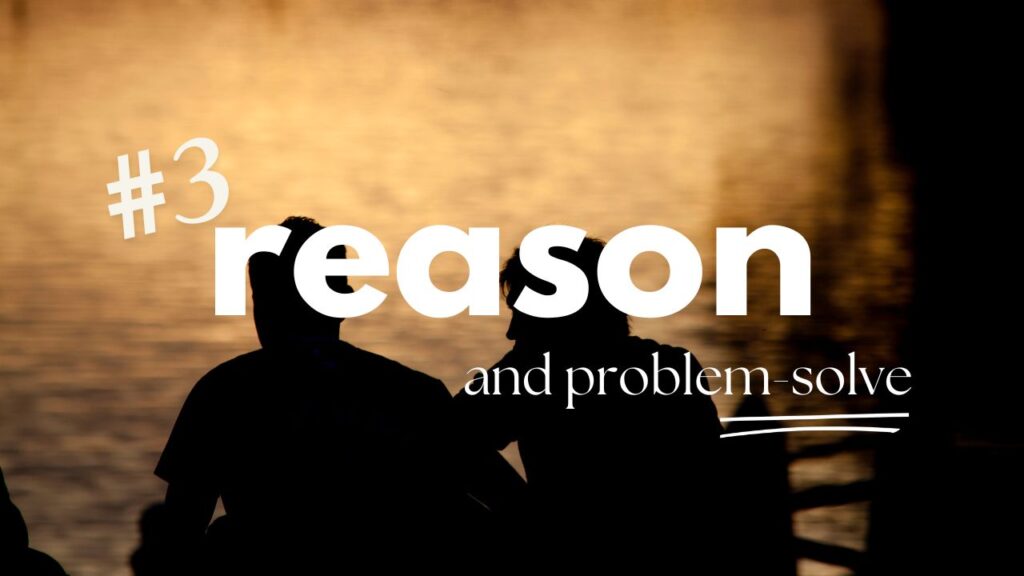
Processing what happened requires you to be able to talk about what happened without starting another fight, so wait until you’re both calm. When you’re ready to process, imagine you’re sitting in the balcony of a theater looking down at yourselves on the stage. Play the situation over again in your mind. How did the argument start? What happened for you? Check-in with your partner to see if they’re ready to share their experience and talk it out together.
Effective Communication:
- Use clear and respectful language when discussing difficult topics. Take turns to say how you felt.
- Avoid blaming or attacking each other. Instead, use “I” statements to express your own thoughts and feelings.
- Practice active listening skills, and empathy, and be curious about each other.
- Remember, defensiveness derails connection.
Reflect Back and Validate your Partner’s Experience:
- “When X happened, I felt X.”
- “I can understand how you felt that way.”
- “It sounds like you were very upset and hurt by what I said.”
- “I didn’t know that’s how I came off.”
- “So, when I raised my voice, that made you feel attacked.”
If you need more context or clarification before validating, ask open-ended questions:
- “Can you tell me more?”
- “How did you feel about X?”
- “What was that like?”
- “Help me understand, I’m listening.”
- “What came up for you?”
- “What do you need?”
Problem-Solving:
Once both partners are calm and connected, you can start to address issues and conflicts rationally. Talk about what can you each do better or differently next time. Practice perspective-taking. Focus on finding solutions that work for both of you. Encourage your partner to tell their story. Support them to remember and reflect. Do the same for yourself.
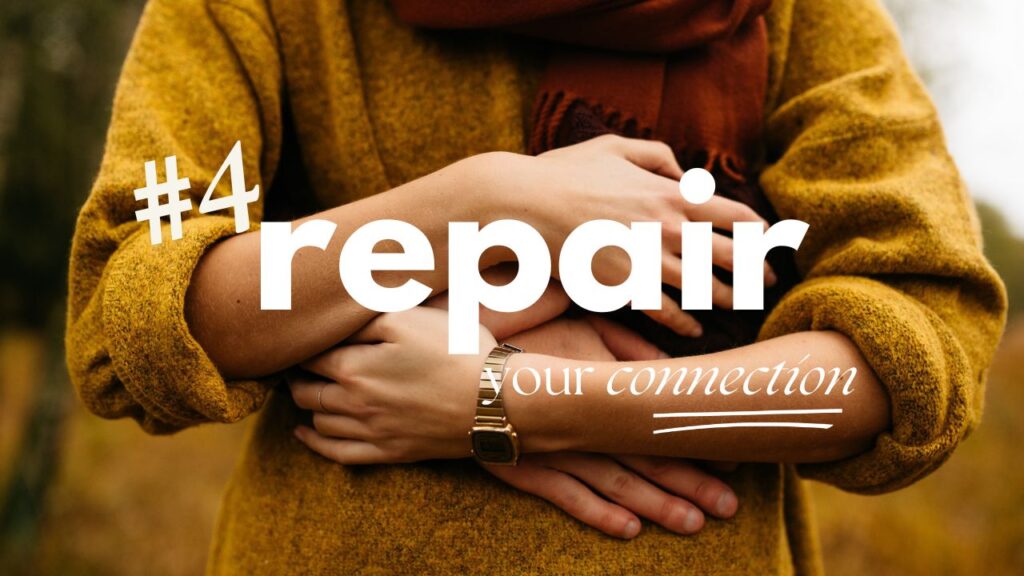
Research shows that the success or failure of a couple’s repair attempts is one of the primary factors in whether a relationship is likely to flourish or hurt. Repair conversations can be bonding as they open up space for the vulnerability that was blocked by protections during the conflict. Repairs are, therefore, a very important part of healthy relationship.
To repair in your relationship:
- Rebuild trust and safety by opening lines of communication again.
- Take responsibility in resolving the situation instead of blaming yourself or your partner.
- Think together to find a way to repair and restore the situation and reconnect.
- Accept each other’s influence.
Use restorative language and nurturing approaches like:
- “I know this wasn’t your fault.”
- “Thank you for sharing this with me. Thank you for saying/doing X, it helps me feel X.”
- “I see your point.”
- “I messed up, I can see my part in this.”
- “I’m sorry I’ve been critical, neglectful, dismissive, explosive and that makes you feel unsafe, scared, hurt..”
- “I love you.”
- “I am sorry, please forgive me, thank you!”
- “I’m here for you. I’m in your corner.”
- “What do you need in this moment?”
- “Can I hug you? Can you hold me?”
- Practice a 6-second kiss, and 20-second hug when you both feel ready.
- Do something you both enjoy or something new together.
- Laugh together.
Every conflict offers an opportunity for a deeper understanding of each other. Building a happy, healthy relationship is hard work and requires growth from both partners. At times, this can mean processing difficult events and tolerating discomfort. Stay curious and remember it’s not what you fight about that matters, but how you repair and move forward together.
The Gottman Method
TL; DR:
- The 3 R’s + R provides a structured approach to resolving conflicts, leading to more satisfying and lasting solutions.
- By focusing on regulation and connection, couples can deepen their emotional bond and trust.
- By learning to regulate own emotions and connect, couples can build a stronger foundation for weathering relational and life’s challenges.
Sources: